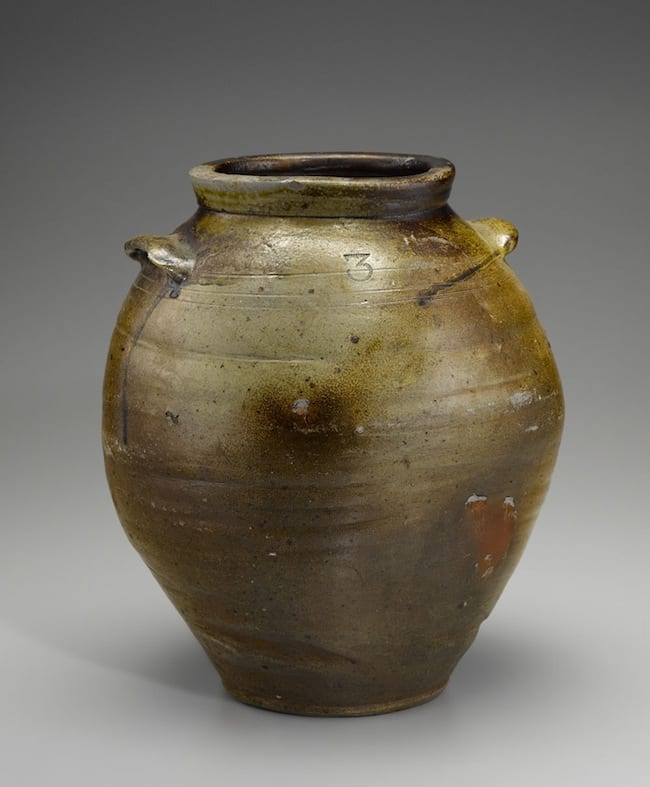The following essay, Jars of Utility comes to us from Robert Hunter, the editor of Ceramics in America. In it he discusses the 19th-century stoneware industry in America, accompanied by photographs by Gavin Ashworth:
While the earliest European colonists to the New World were soon making ceramics, it was not until the early 19th century when widespread production of utilitarian stoneware became a hallmark of the American ceramic industry. Organized along family lines, great potting dynasties arose in the urban centers of Boston, Albany, Manhattan, Philadelphia, Baltimore, Alexandria, and Richmond. Smaller factories arose in rural areas throughout the country to serve regional needs.
Stoneware vessels thrown on the wheel and fired in wood-stoked kilns came in every shape and size and were used by urban and rural households alike. In the absence of refrigeration, the storage jar filled the void as a receptacle for salted and pickled foodstuffs. These inexpensive jars were produced in huge, almost unimaginable quantities. The need for stoneware products ultimately gave way to the glass industry and the tin container.
Although primarily utilitarian in performance, a tremendously diverse range of surface treatment and decorations was applied to these jars. These decorations not only reflect regional tastes but also social, political, and historical concerns. On a deeper level, however, these decorated jars document the human need for artistic expression whether it be on the stone walls of the Lascaux Caves or the stone walls of a kitchen jar made in Morgantown, West Virginia. What follows are just a few examples of 19th-century American stoneware that illustrate the variety of expression and the inherent beauty of the potter’s art that became part of the American domestic mindscape.
Above image: A three-gallon salt-glazed stoneware jar, ca. 1820, probably originating in New Jersey. Photograph by Gavin Ashworth.

Ten gallon alkaline-glazed stoneware jar, ca. 1845, made by Thomas Chandler, Edgefield, South Carolina.

Two-gallon, salt-glazed stoneware churn, 1829. Made by Thomas Chandler, Baltimore, Maryland.

20-gallon alkaline-glazed stoneware jar, ca. 1840. Made by David Drakard, Edgefield, South Carolina.

Five-gallon salt-glazed stoneware jar, ca. 1850. Made by Stephen Sweeney, Richmond, Virginia.

Two-gallon salt-glazed stoneware jar, ca. 1818-1822. Made by Thomas Amoss, Richmond, Virginia.

One-gallon salt-glazed stoneware jars, ca. 1810-1820. Made by John Swann, Alexandria, Virginia.

Two-gallon salt-glazed storage jar, ca. 1850-1860. Made by Remmey Pottery, Philadelphia, Pennsylvania.

Two-gallon salt-glazed jar with iron slip, ca. 1805-1810. Originating in South Amboy, New Jersey.

Four-gallon salt-glazed storage jar, ca. 1830. Made by John P. Schermerhorn, Richmond, Virginia.

Three-gallon salt-glazed stoneware jar, ca. 1860. Made by John Thompson of Morgantown, West Virginia (then Virginia).

Three-gallon salt-glazed jar, ca. 1865. Made by John Greenland of Union Pottery, Uniontown, Pennsylvania.

Five-gallon alkaline-glazed stoneware jar, ca. 1840. Made by slaves in Edgefield, South Carolina.

Two-gallon salt-glazed stoneware jar, 1841. Made by Henry Lowndes, Petersburg, Virginia.

Two-gallon salt-glazed stoneware jar with Albany slip, ca. 1809. Made by Paul Cushman, Albany, New York. All photographs by Gavin Ashworth.

Thank you for the informative article and the beautiful pictures. Very much appreciated!
Great article and photos
Thank You
You’re welcome, Melody.